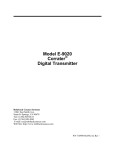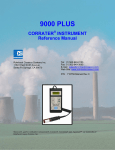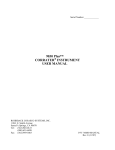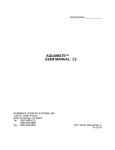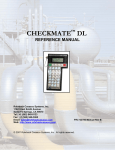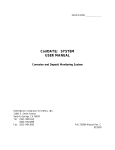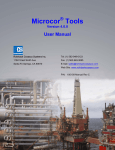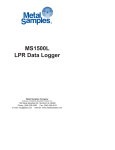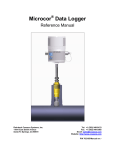Download Randell RANFG SCA-6 User manual
Transcript
Model SCA-1 Corrater® Model SCA-1L Corrater® Corrosion Monitor User Manual ROHRBACK COSASCO SYSTEMS, INC. 11841 E. Smith Avenue Santa Fe Springs, CA 90670 Tel: (562) 949-0123 (800) 635-6898 Fax: (562) 949-3065 P/N 710514-Manual Rev.-B Revised: 11/3/04 Serial Number: CORROSOMETER®, CORRATER® are all registered trademarks of Rohrback Cosasco Systems Inc. All rights reserved. SCA-1/SCA-1L Corrater User Manual i SCA-1/SCA-1L Corrater User Manual ii Table of Contents Chapter 1 Introduction...................................................................................................................... 1 Chapter 2 Specifications .................................................................................................................. 3 Chapter 3 Installation........................................................................................................................ 5 Chapter 4 Operation.......................................................................................................................... 9 Chapter 5 Maintenance................................................................................................................... 11 Chapter 6 Warranty ......................................................................................................................... 13 Chapter 7 SCA-1L Internal Data Logger Option .......................................................................... 15 Appendix A Theory of Operation of CORRATER® Systems...................................................... 19 Appendix B 2 Element Solution Resistivity Correction Curve .................................................. 25 Appendix C Manufacturer’s Declaration of Conformity ............................................................. 27 SCA-1/SCA-1L Corrater User Manual iii SCA-1/SCA-1L Corrater User Manual iv Chapter 1 Introduction 1.0 GENERAL RCS CORRATER® systems are designed to help improve facility operations by enabling the user to directly monitor the corrosion rate in electrically conductive liquid systems. CORRATER® systems operate on the fundamental principle that a metal corroding through oxidation will generate a small electrical current. A CORRATER® instrument determines the corrosion rate by measuring the current from a small applied potential difference between the two electrodes. This technique of determining corrosion rate is generally referred to as Linear Polarization Resistance (LPR). A discussion of the LPR method of corrosion rate measurement is presented in Appendix A of this manual. 1.1 MODEL SCA-1 The SCA-1 single channel CORRATER® instrument is a field-installed corrosion monitor for cooling or potable water systems. It is available in four ranges: 0 - 2 mpy, 0 - 20 mpy, 0 - 50 µmpy and 0 - 500 µmpy. The two lower ranges (0 - 2 mpy and 0 - 50µmpy) are recommended for low corrosion applications such as monitoring lead or copper corrosion in potable water systems. The two higher ranges (0 - 20 mpy and 0 500 µmpy) are recommended for monitoring treatment of cooling water systems where corrosion rates are expected to exceed 2 mpy. Note that this instrument does not measure pitting tendency and is not solution resistance compensated. Therefore, the recommended operating range, without the use of correction curves, is where the conductivity of the water in micromhos/cm (µmho/cm) divided by the corrosion rate in mils per year (mpy) is greater than 100. If this quotient is less than 100, solution resistivity correction curves are recommended. Please refer to Appendix B for the correction curve for 2 electrode CORRATER® measurements. The instrument is built within a weatherproof NEMA 4X enclosure (when the clear cover is installed) for mounting in the vicinity of the process to be monitored. It comes with an integral six-foot cable and standard type B connector for connection to any CORRATER® probe. Optional extension cables or existing CORRATER® extension cables can be directly connected between the instrument and probe up to a maximum of 100 feet. Power connection is with an integral six-foot cable. Permanent mounting is achieved by machine screws through the corner through holes. After installation, the operator only needs to set the appropriate front panel switch for the multiplier that corresponds to the electrode material being used. The measurement cycle is 15 minutes, after which the display will show the corrosion rate on a continuous basis. In addition to the digital display one of the five LED indicators will light to show the corrosion rate as a percentage of full scale, i.e. 10, 25, 50, 75 or 100%. An optional 4 to 20 mA current loop output is available for a recorder or data acquisition system. The SCA-1 sources the current to a maximum load resistance of 600 ohms. Since the output is current sourcing, caution should be exercised when connecting to another system so that interconnection does not cause excessive currents to flow in the output circuit. The SCA-1L is supplied with a HOBO® data logger. The 4-20 mA current loop output is fed directly into the internally housed data logger, and is not available for other external recorders. A RS 232 output for the data logger is located in the center of the bottom side of the unit to launch and retrieve data using the BoxCar® Pro software and supplied cable. SCA-1/SCA-1L Corrater User Manual 1 Chapter 1 Introduction 1.3 SCA-1 MANUAL This manual is intended to be a working guide to the installation and operation of a CORRATER® system based on the SCA-1 instrument and two-electrode CORRATER® probes. Sections 2, 3 and 4 provide the user with the basic information required to install and use the SCA-1 instrument. Section 5 contains maintenance information, Section 6 contains the warranty and returned goods procedure, and Section 7 contains some tips on using the Hobo® Data Logger and BoxCar® Pro software. SCA-1/SCA-1L Corrater User Manual 2 Chapter 2 Specifications 2.0 OPERATIONAL Range: Single range: 0 - 2 µmpy, 0 - 20 µmpy, 0 - 50 µmpy or 0 - 500 µmpy. (Selected at time of purchase). Accuracy: ±5% of full scale. (Based upon a Randall's equivalent circuit). Resolution: 0.5% of full scale. Cycle Time: 15 minutes (fixed). Corrosion Rate Display: 3 digit LED. Corrosion Rate Indication: LED indicators for 10, 25, 50, 75 and 100% of full scale. Multiplier Selection: 1.00, 1.67, 2.00 or 2.57 which accommodates most alloys. Analog Output: (-1 Option) 4 to 20 mA, current sourcing into 1,000 ohms maximum. Power: 115 or 230 VAC, 50/60 Hz, 10 watts. 2.1 ENVIRONMENTAL Operating Temperature Range: 32ºF to 140ºF (0ºC to 60ºC). Non-operating Temperature Range: -37ºF to 185ºF (-40ºC to 85ºC). Enclosure: NEMA 4X with clear cover installed. 2.2 MECHANICAL Size: 8.89"L x 4.92"W x 2.95"H. 175 mm L x 125 mm W x 75 mm H. Weight: 2.5 pounds (1.1 Kg.). 2.3 INTERFACE Probe: SCA-1/SCA-1L Corrater User Manual 6 ft. integral probe cable with type B connector compatible with all CORRATER® probes and type C or type S adapters for Model 6080 high pressure probes. 3 Chapter 2 Specifications Power: 115 VAC – Eight-foot (2.5 meter) power cable with standard 3-prong North American plug. NOTE: This plug is not intended for use in countries where compliance is required for those countries, install an approved, compliant plug in accordance with local regulations. 230 VAC compliant eight foot (2.5 meter) power cable and plug with European agency approvals. NOTE: If it is necessary to replace the plug, install an approved, compliant plug in accordance with local regulations. 4 - 20 mA Output (Option): Two-terminal internal terminal strip to accommodate up to 14 Ga. wire. SCA-1L Data Logger Output (Option): RS-232C downloads of Stored Data to IBM PC or equivalent. Data logger stores over 7750 data points, or 82 days of data @ 15 minute cycle time. Fuse: 5 x 20 mm Type T (time lag or slow blow). 115 VAC - Use 0.250 Amp rating. 230 VAC - Use 0.125 Amp rating. Installation Category: Overvoltage Category II. Protected for transient overvoltages common to portable equipment. SCA-1/SCA-1L Corrater User Manual 4 Chapter 3 Installation 3.0 GENERAL The Model SCA-1 is a field-mountable instrument that is designed to be mounted on a wall, bulkhead or other vertical surface. The mounting is achieved by using four #6-32 pan head machine screws in the corners of the enclosure. Figure 3-1 provides dimensional information for mounting the SCA-1. 3.1 POWER The instrument is supplied with an eight foot (2.5 meter) cable which is terminated with a standard threecompliant, European approved plug for 230 prong North American plug for 115 volt operation, and with a volt operation. The cable conductors are color coded with IEC standard colors (LIVE - brown, NEUTRAL blue, GROUND - green/yellow. If it is necessary to replace the plug, install an approved plug in accordance with local regulations. CAUTION: The power supply voltage must correspond to that specified on the power cord and on the instrument label located on the bottom of the unit. The last three digits of the part number specify the voltage either -115 or -230. SAFETY NOTE: To protect operating personnel it is necessary the instrument be grounded. To accomplish this, the offset (round) prong on the furnished power plug must be connected to the facility ground. If the power plug is removed from the cable, it is then necessary that the green/yellow insulated wire be grounded. 3.2 CORRATER® PROBES The SCA-1 is intended to be used with any standard 2-electrode CORRATER® probe. The probes are available in many designs including fixed, adjustable, retractable and retrievable. Also, probe electrodes are available in many different alloy materials. The material selected should closely match the material of construction of the pipe or vessel for which corrosion information is desired. Probes should be installed where corrosion is most likely to be greatest in order that readings will truly represent the most aggressive system corrosion rates. Preferably, they should be located where liquid flow velocity past the electrode exceeds 1 foot per second (0.3 m/sec.). Alignment of the electrodes relative to the direction of flow velocity is extremely important to obtain accuratecorrosion rate measurements. Proper alignment is with the imaginary line connecting the centerlines of the two electrodes perpendicular to the direction of flow velocity. Refer to Figure 3-2. With this orientation one electrode does not "shade" the other electrode, and both are subject to nearly the same corrosive environment. If a probe is installed in an elbow fitting, where flow changes direction, position the probe so that the electrodes "face" the oncoming flow. Refer to Figure 3-3. 3.3 PROBE CONNECTION The SCA-1 is supplied with an six foot probe cable that is terminated in a 6 pin type "B" connector which is suitable for direct connection to all CORRATER® probes. The only exception is interconnection to a Model 6080 High Pressure CORRATER® probe where a fixed probe adaptor P/N 028068 is necessary. SCA-1/SCA-1L Corrater User Manual 5 Chapter 3 Installation Should the distance from the installed probe to the instrument exceed six feet, an optional extension cable up to 100 feet can be used. To order, use Model No. CBL2-B-B-O-O-LL where LL is the cable length in feet. 3.4 CURRENT LOOP OUTPUT OPTION If your SCA-1 has been purchased with the 4-20 mA current output option, the interconnection is made with a pair of twisted #14 or smaller wires from the terminal strip shown in Figure 3-4 to the recorder or the 4-20 mA receiver. CAUTION: The SCA-1 provides an isolated output of 4-20 mA and no other loop power supply is required. Connection to a loop that sources power may cause damage to the SCA-1 and/or other equipment. 3.5 INTERNAL DATA LOGGER OPTION If your SCA-1 has been purchased with the internal data logger option, the connection to the data logger is made through a RS 232 interface located in the same place as the 4-20 mA gland entrance shown in figure 3-4. The 4-20 mA output has been used internally, and is not available for other use. FIG 3-1 SCA-1/SCA-1L Corrater User Manual 6 Chapter 3 Installation FIG 3-2 FIG 3-3 SCA-1/SCA-1L Corrater User Manual 7 Chapter 3 Installation FIG 3-4 SCA-1/SCA-1L Corrater User Manual 8 Chapter 4 Operation 4.0 GENERAL The Model SCA-1 is intended for continuous corrosion monitoring of cooling water systems and therefore does not require operator actions for operation other than those required for setup. 4.1 INITIAL SETUP After installation, only the front panel DIP switch needs to be set for the multiplier for the alloy in use. When the SCA-1 testing is completed at RCS, the multiplier is set to the MILD STEEL position. Please refer to Table 4-1 (see next page) for recommended multiplier selections. If an alternate selection is required, remove the clear cover from the SCA-1 and depress the RIGHT side of the appropriate multiplier selection with a pen or pencil point until it clicks. The remaining three switches should be depressed on the LEFT side. This is all that is required for the initial setup. NOTE: If the SCA-1 is powered when the multiplier is selected, power must be interrupted for approximately 10 seconds for the change to be accepted. 4.2 STARTUP Connect the CORRATER® probe to the SCA-1 and make sure the probe is properly inserted in the flow. Power can now be applied to the SCA-1 and the measurement cycle will be initiated. The first corrosion rate reading and percentage of full scale indication will be available after the first 15 minute measurement cycle. The display and indicators will be updated every 15 minutes thereafter. Should the measured corrosion rate exceed the full scale of the range of the instrument, the display will show "or", indicating over range. After the corrosion rate decreases to an in-range value, the display will return to showing the corrosion rate value in engineering units. SCA-1/SCA-1L Corrater User Manual 9 Chapter 4 Operation TABLE 4-1 CORRATER® MULTIPLIER FACTORS NOTE: These factors are recommended for use with the Model SCA-1 when setting the MULTIPLIER value, as described in Section 4-1. They are based upon use of CORRATER® electrodes which have surface areas of 5cm2 for "standard" probes. ALLOY UNS CODE RCS CODE MULTIPLIER MILD STEEL K03005 K03005 MILD STEEL AISI 1010 CARBON STEEL G10100 8001 MILD STEEL AISI 1020 CARBON STEEL G10200 8003 MILD STEEL AISI 304 STAINLESS STEEL S30400 8013 MILD STEEL AISI 304L STAINLESS STEEL S30403 8014 MILD STEEL AISI 316 STAINLESS STEEL S31600 8020 MILD STEEL AISI 316L STAINLESS STEEL S31603 8021 MILD STEEL ALUMINUM 1100 A91100 8080 MILD STEEL ALUMINUM 2024 A92024 8085 MILD STEEL COPPER 110 ETP C11000 8061 COPPER ARSENICAL ADMIRALTY BRASS CDA #443 C44300 8073 ADMIRALTY BRASS ALUMINUM BRASS ARSENICAL CDA #687 C68700 8064 ADMIRALTY BRASS COPPER/NICKEL 90/10 CDA #706 C70610 8062 ADMIRALTY BRASS COPPER/NICKEL 70/30 CDA #715 C71500 8060 ADMIRALTY BRASS MONEL 400 NO4400 8054 MILD STEEL CARPENTER 20 CB-3 N08020 8043 MILD STEEL LEAD L50045 L50045 LEAD TITANIUM, GR 2 & 4 R50400 8093 MILD STEEL SCA-1/SCA-1L Corrater User Manual 10 Chapter 5 Maintenance 5.0 INTRODUCTION Routine maintenance on the SCA-1 is not required. There is no initial calibration or periodic calibration required. Probes, however, require regular maintenance and scheduled replacement in order to perform satisfactorily. Probes are covered in sections 5.2 for probe replacement, 5.3 for electrode cleaning, and 5.4 for electrode replacement. If a problem with the SCA-1 is suspected, section 5.1 describes tests to verify proper operation of the instrument. 5.1 USER TEST If a problem in the instrument is suspected, you may perform the following series of tests to verify operation of the instrument and isolate the fault: 1) Remove power from the instrument; 2) Remove the protective plastic cover, note the position of the multiplier switch, then change the switch to the mild steel selection; 3) disconnect the integral probe cable from the probe or probe extension cable and attach the test probe which was supplied with the instrument (Part No. 011001 for 2 MPY and 50 UMPY units, 011000-5 for 20 MPY and 500 UMPY units) to the probe cable; restore power to the instrument and wait for the fifteen-minute reading cycle to be completed. If the reading agrees with the value printed on the test probe, then the problem is probably in the extension cable, if used, or in the probe itself. NOTE: You must wait a full 15 minutes for the instrument to complete a measurement cycle with the multiplier in the MILD STEEL setting. If the instrument read the test probe correctly when attached directly and a probe-to-instrument extension cable is in use, you may repeat the test with the test probe moved to the end of the extension cable and the instrument reconnected to the extension cable. Again, the reading should agree with the reading of the test probe when no cable is attached. If both of these tests pass, then the SCA-1, the cable, and all the connectors are o.k. Any remaining problems are likely caused by the probe or the process itself. A fouling problem, for example, can bridge the electrodes and yield readings that are off scale. NOTE: 5.2 Be sure to return the multiplier switch to its original position after testing. PROBE REPLACEMENT Although the SCA-1 will last indefinitely, the probes and probe elements that are used with it have a very definite life span, and must be replaced on a regular basis. A probe element replacement schedule should be established with a criterion such as 1/32" (0.794 mm) loss of diameter. 5.3 ELECTRODE CLEANING As supplied from the factory, CORRATER® electrodes have blasted surfaces and require no further cleaning before they are used. However, should the electrodes become fouled with corrosion products or other materials, they should be cleaned and polished to a dull shine with an emery cloth. After cleaning, the electrodes should be thoroughly degreased in a suitable solvent, and handled with a clean cloth or paper towel to prevent contamination. SCA-1/SCA-1L Corrater User Manual 11 Chapter 5 Maintenance Electrodes should be replaced when the diameter is 1/32" (0.794 mm) less than the original. When installing new or cleaned electrodes, handle them with a clean cloth or paper towel to avoid depositing any contaminating oily film. 5.4 ELECTRODE REPLACEMENT CORRATER® electrodes, when new, at 3/16" (4.76 mm) diameter by 1 1/4" (31.75 mm) long cylinders. As corrosion occures on the electrodes, their diameter decreases and at some point the reduced diameter begins to significantly affect the accuracy of the corrosion readings. It is recommended that CORRATER® electrodes be replaced when their diameter has been reduced to 5/32" (3.97 mm). 5.5 ELECTRODE PRETREATMENT Pretreatment of the electrode is done in order to stabilize the instrument readings. Generally, a full strength sample of the treatment chemical is used. The new electrodes are carefully placed into the solution for a 612 hour period and then threaded onto the probe and placed into service. Because the electrodes have been saturated with the representative treatment solution, their equilibration time is lessened. The resulting data, generated from the readings, will show the corrosion trend earlier. Without pretreatment, the equilibration time can be as much as one week. 5.6 CORRELATION WITH ELECTRODES AS COUPONS Weigh the electrodes in the same manner as a coupon would be weighed, on a balance graduated to 0.0001g before placing them in service. The coupon should be placed into service at the same time. After a 30 or 60 day period, remove both, clean them and analyze them in the same manner. The readings from the instrument integrated over a period of time, and the data from the electrodes and coupons should correlate. SCA-1/SCA-1L Corrater User Manual 12 Chapter 6 Warranty 6.0 SPECIAL WARRANTY POLICY FOR THE SCA-1 CORRATER® This warranty applies to the following Rohrback Cosasco Systems equipment and systems sold in the United States by Rohrback Cosasco Systems. SCA-1 CORRATER® Subject to the conditions herein, Rohrback Cosasco Systems agrees, upon prompt notification, to correct either by repair, or at its election, by replacement, any defect of material or workmanship which develops within ninety (90) days after startup, or six (6) months from date of shipment to the original purchaser, whichever comes first, provided that an investigation and inspection by Rohrback Cosasco Systems discloses that such defect developed under normal and proper use. 6.1 CONDITIONS 6.1.1 Rohrback Cosasco Systems will provide a field service engineer, if the customer requires field inspection, at non-reimbursable current standard rates plus all reasonable travel and living expenses or, 6.1.2 All items claimed defective may be returned to Rohrback Cosasco Systems, or an authorized field service center, transportation charges prepaid, and will be returned to the customer with the transportation charges collect. 6.1.3 Rohrback Cosasco Systems shall be released from all obligations under its Warranty if the instrument or parts thereof are physically abused, damaged, lost, or are damaged by improper installation, connections, start-up, application or for other reasons beyond the control and responsibility of Rohrback Cosasco Systems. Further, Rohrback Cosasco Systems shall be released from all obligations under its Warranty in the event repairs or modifications are made by persons other than its own or authorized service personnel, unless such repairs by others are made with written consent of Rohrback Cosasco Systems, or unless such repair is merely the installation or a new plug-in component or standard accessory supplied by Rohrback Cosasco Systems for this purpose. What constitutes damage covered or not covered under the conditions of this Warranty shall be determined solely by Rohrback Cosasco Systems, after Rohrback Cosasco Systems is in possession of all facts it judges pertinent and pertinent and necessary to make such a determination. 6.1.4 Rohrback Cosasco Systems makes no Warranty concerning components or accessories (such as recorders or computers) not manufactured by it. However, in the event of the failure of any component or accessory not manufactured by Rohrback Cosasco Systems, Rohrback Cosasco Systems will give reasonable assistance to the customer in obtaining from the respective manufacturer whatever adjustment is reasonable in the light of the manufacturer's own Warranty. Except to the extent expressly stated in this agreement, Rohrback Cosasco Systems makes no Warranty, express or implied (either in fact of by operation of law), statutory or otherwise; and except to the extent stated above, Rohrback Cosasco Systems SCA-1/SCA-1L Corrater User Manual 13 Chapter 6 Warranty shall have no liability under Warranty, express or implied (either in fact or by operation of law), statutory or otherwise. 6.2 OTHER PRODUCTS All other products, components, and accessories such as probes will be warranted in accordance with the conditions printed on the reverse of Rohrback Cosasco Systems' standard quotation form. SCA-1/SCA-1L Corrater User Manual 14 Chapter 7 SCA-1L Internal Data Logger Option 7.0 GENERAL As an option, the SCA-1 is provided with an internally mounted HOBO® H8 data logger to store the 4-20 mA output of the SCA-1. The BoxCar® Pro software must be used to configure and retrieve data from the data logger. The BoxCar® Pro User’s manual is supplied with the software, and is the primary reference for software operation. The details provided below are meant as a guide to assist in the set up of the data logger and analysis of the data. HOBO® and BoxCar® Pro are registered trademarks of Onset Computer Corporation. 7.1 Data Logger Power Supply Three triple A (AAA) batteries are used to power the data logger inside the SCA-1. These batteries should provide power to the data logger for a minimum of one year. When launching the data logger, a “fuel supply” gage on the PC screen indicates the power left in the battery. It is recommended that the batteries be replaced when the fuel gage reads ¼ full. To change the batteries, the following is recommended: 1) 2) 3) 4) 5) 6) 7) 8) 9) 7.2 DISCONNECT POWER FROM THE SCA-1! Remove the four corner screws and the then the cover on the unit. Remove the four face plate screws. Gently lift the faceplate out of the box. Turn face plate over, the batteries will be plainly visible. Replace batteries. Place faceplate back in position. Replace the four faceplate screws. Place the cover back on the unit, and install the four corner screws. Data Logger Configuration The Data Logger is configured using the BoxCar® Pro Software. Follow the HOBO® H8 Quick Start directions in the BoxCar® Pro User’s manual. The following settings should be used during the launch sequence (Choose Launch From the Logger Pull Down Screen): SCA-1/SCA-1L Corrater User Manual 15 Chapter 7 SCA-1L Internal Data Logger Option Figure 7A Basic Options Description: Enter information to identify the location being tested. Interval (Duration): The SCA-1 has a 15 minute measurement cycle, and the recording interval should be set at 15 minutes, or multiples of 15. At a minute interval, data can be collected for 82 days before collection will stop, or the oldest data will be written over. Select Wrap Around when full IF you want the oldest data to be over written. Figure 7B Advanced Options — Measurement Unit: Select “Enable/Disable Channels” on Launch screen, then select 2nd channel and scroll to the last option “4-20 mA Input Cable (cable 4-20-mA)”, and click “apply”. Press Start, and the data is being stored. SCA-1/SCA-1L Corrater User Manual 16 Chapter 7 SCA-1L Internal Data Logger Option Configuration is now complete, and your screen should look like figure A. Press Start, and the data is being stored. 7.3 Data Retrieval Figure 7C Using the BoxCar® Pro Software, Select “Readout” under the “Logger” menu. The data is off- loaded to your computer. Name the file, and select the directory where the file should be stored, then select “OK”. 7.4 Data Analysis Figure 7D SCA-1/SCA-1L Corrater User Manual 17 Chapter 7 SCA-1L Internal Data Logger Option The data can be scaled and labeled in Microsoft Excel® or Lotus 123®. To export the data to a spreadsheet program, choose “Export” under the “File Menu”, and select the appropriate software program. Next, click on the “export” box, and enter the file name and destination folder. The file is exported as a tab delimited “.txt” file. This step must be done when the file is open in the Boxcar software. Open the spreadsheet program, and then open the exported file. The exported file will have a “.txt” suffix, and you may need to select “all files”, after selecting open in the spreadsheet program. After opening the file, follow the spreadsheet prompts of the import wizard choosing “Delimited” as the separation type, and “Tab” as the delimiter. The spreadsheet now contains two columns of data, the first is time and date, second is the 4-20 mA output. To scale the output to corrosion rate, the mA output should be inserted into the following formula: Instrument Range 0-2 mpy 0-20 mpy 0-50 µmpy 0-500 µmpy Formula [(mA - 4)/16]×2 [(mA - 4)/16]×20 [(mA - 4)/16]×50 [(mA - 4)/16]×500 The range of your instrument is printed as part of the serial number on the tag on the side of the instrument. Use the spreadsheet graphing capabilities to graph the data. SCA-1/SCA-1L Corrater User Manual 18 Appendix A Theory of Operation of CORRATER® Systems THEORY OF OPERATION FOR THE POLARIZATION RESISTANCE METHOD OF CORROSION RATE MEASUREMENT Introduction Corrosion is an electrochemical process generally occurring when a metal is in contact with an electrically conductive liquid such as water solution. At the interference between the metal and the liquid, the immediate corrosive reaction is that some metal atoms at the surface become positively charged and give up electrons into the metal and become positive ions (cations) in the liquid. Since the metal cannot accumulate electrons, a second immediate reaction must simultaneously take place. The metal must conduct electrons to some specie(s) in the liquid resulting in either the neutralization of positive ions or the creation of negative ions (anions). The first reaction (where electrons enter the metal is "anodic" and is called oxidation, and the second reaction (where electrons leave the metal) is "cathodic" and is called reduction. On a metal surface, the anodic and cathodic areas are generally microscopic in size, and are unstable in that they move around as local interfacial conditions change. An example of an anodic reaction, involving iron is: Iron Oxidation Fe→ Fe+2 + 2e Examples of cathodic reactions which occur are: Hydrogen evolution 2H+ + 2e→ H2 Oxygen reduction or 02 + 4H+ + 4e → 2 H20 02 + 2 H20 + 4e → 4 0H- As stated, the above are the immediate anodic and cathodic electrochemical reactions which occur. Subsequent reactions take place, for instance, ferrous ions may join with hydroxyl ions to form ferrous hydroxide (Fe(0H)2). Several other ion products may also be formed, such as ferrous oxide (Fe0) and ferric oxide (Fe203), which are commonly referred to as "rust". The rate of naturally occurring electrochemical oxidation (corrosion) is dependent upon a multitude of parameters including metal composition, homogeneity, intergranular structure, surface finish, oxidation products, liquid temperature, pH, dissolved oxygen and other gasses, flow velocity, and certainly the chemical content and physical characteristics of the liquid itself. The polarization resistance method of measuring corrosion rate comprises a means to measure the electrical (electron-ion interchange) resistance at the interface between a metal element of known surface area and a liquid, without significantly disturbing the natural conditions of that interface. The metal element, or the "test element", which is inserted into the liquid must closely match the material of construction (pipe or vessel) for which the corrosion rate information is required. As will be shown, the measured interfacial resistance (herein called "polarization resistance") is an inverse function of the corrosion rate. SCA-1/SCA-1L Corrater User Manual 19 Appendix A Theory of Operation of Corrater® Systems The relationship among the Electrochemical Reactions, Corrosion Current, Polarization Resistance, and Corrosion Rate Because the metal undergoing the corrosive (anodic) action cannot accumulate electrons, the amount of cathodic reaction (electrons released) must exactly equal the amount of anodic reaction (electrons accepted when the metal is in its natural state - not connected to an external source of current. In other words, at the natural corrosion potential, Ecorr, the net reducing current, iR, must equal the net oxidizing current, i0. Thus: iΟ & iú ' O at Ecorr Also, by definition, the corrosion current, icorr, is equal to the net oxidizing current; thus, at the natural corrosion potential, Ecorr: icorr ' iΟ ' iú Unfortunately, icorr, which is proportional to corrosion rate, cannot be directly measured. However, if a metal test element of known surface area were inserted into a liquid, and another metal element were also inserted into the liquid, an electrical current can be forced by external means between the test element to the other element. When this is done, the potential of the test element is forced to a value other than Ecorr. Also because of externally supplied electrons to or from the test element, iR is no longer equal to i0. Under this condition, a current, imeas, can be measured and imeas ' iΟ & iú … O Depending upon the direction of the supplied current, the test element is made either more anodic or more cathodic. The voltage change of the test element from Ecorr is called the polarization potential or overvoltage, ∆ E; thus, ∆E ' Eapp & Ecorr where Eapp is the voltage applied which was required to cause the measured current, imeas. If the polarization potential is kept small so as not to disturb significantly the natural corrosion process, the overvoltage, ∆ E, is linearly related to the measured current, imeas. Their ratio ∆ E/imeas is referred to as the "polarization resistance", Rp, of the test element. Theoretical work published by M. Stern and A.L. Geary in 1957 demonstrated that polarization resistance is related to corrosion current by this equation: Rρ ' Ba Bc 2.3 i corr (Ba % Bc) where Ba and Bc are the anodic and cathodic slopes of plots of the log of current vs. applied voltage, respectively, in the units of volts (per decade of current change). These slopes are usually referred to as "Tafel Slopes". Often the symbol "B" is used to represent the combined proportionality function. Thus, B= B a Bc 2.3 (Ba + Bc) and SCA-1/SCA-1L Corrater User Manual 20 Appendix A Theory of Operation of Corrater® Systems Rρ = ∆E i meas = B i corr It has been found that for most flowing industrial aqueous systems where the corroding metal is iron, cobalt or nickel, or alloys of these metals, the value of B is approximately .025 volts. Also, for iron alloys, the constant relating corrosion current density to corrosion rate is, by Faraday's Law, 2.2 microamps per square centimeter per mil per year (mpy). Thus, the following equations relate corrosion rate, Cr, corrosion current and polarization resistance for an iron alloy test element of unit (1 cm2) area: Cr(mpy) ' 1 .025 x 10 6 11,400 x i corr (µA) ' ' 2.2 Rρ (ohms) 2.2Rρ (ohms) For test elements of other surface areas, the above numerical values would be appropriately changed. Thus, for the commonly used 5 cm2 test element, the relations would be: Cr (mpy) ' 1 2,280 i (µA) ' 11 corr Rρ (ohms) E , if we apply a small fixed-value ∆ E such as 5.0 mV, Rp in the above imeas equation may be replaced with 5.0/imeas, where imeas is in mA measured to the 5 cm2 test element. Thus, the corrosion rate equation may be stated: Because Rp = C r (mpy) ' 456 i meas (mA) ' 0.456 i meas (µA) Practical Considerations Even though an applied ∆ E is kept small so as to have minimal effect upon the natural processes, in practical working systems it has been found desirable to reverse the polarity of ∆ E at fixed intervals of time, such as every 60 seconds. The reasons for these reversals are: 1. If the ∆ E were applied continuously at one polarity, this small polarizing voltage would eventually change the natural corrosion processes. 2. Ecorr is not a constant value - it drifts slowly with minute changes in the interface conditions. Thus, Ecorr must be occasionally measured as a reference potential for the Eapp application. 3. Due to Ecorr drift and other changes inherent in the electrochemical system, reversals in polarity allow a means of averaging the absolute values of the resulting positive and negative measured currents, thus canceling out the effects of small short-term drifts. We have discussed application of a ∆ E overvoltage across the test element-liquid interface and measurement of the resulting current, imeas. Of course, to apply the overvoltage, at least one other piece of metal must be inserted into the liquid. Thus, a functional probe must have at least two elements, or electrodes, fixed in a known geometrical orientation. The most common types of corrosion rate probes include either two or three electrodes. Each of these types has its advantages, as will be discussed. An inherent problem with the polarization resistance method is caused by the intrinsic resistivity of the liquid. When a ∆ E is applied, the resulting imeas is not controlled entirely by the Rp at the test surface interface. It is controlled by the sum of Rp and Rs, the solution resistance, which is a function of liquid resistivity and the relative configuration of elements immersed in the liquid. (This problem will be discussed in detail for the specific probe configurations). SCA-1/SCA-1L Corrater User Manual 21 Appendix A Theory of Operation of Corrater® Systems Two-electrode Probe The metal elements (electrodes) in a two electrode probe are made of the same alloy (usually, from adjacent pieces of the same stock material) and to the same dimensions. The reason for closely matching theelectrodes is that they are both simultaneously functioning as test elements. After immersion into a flowing liquid system, the monitoring instrument measures the open-circuit potential, Eoc, between the electrodes. (This voltage is the difference of their individual Ecorr values). To cause current to flow between the electrodes, a fixed voltage is superimposed upon the Eoc value to cause a polarization potential across the interface at each electrode - in the anodic direction at one electrode and in the cathodic direction at the other electrode. The resulting current is measured. After a waiting period of 60 seconds, the fixed voltage polarity is reversed, and again the resulting current is measured over an identical waiting period. The algebraic difference of the two currents existing at the end of each waiting period is directly convertible into a corrosion rate reading, as described above. It should be noted that the superimposed fixed voltage is divided between the interfaces at the two electrodes. For example, if 10 mV is superimposed, approximately 5 mV overvoltage is applied across each interface if the solution resistance, Rs, is negligible. Because the open-circuit potential between the two "identical" electrodes is usually quite low, and also because the measured current amplitudes in both directions are, in effect, averaged, it has been found that little or nothing is gained by measuring Eoc and superimposing an activating voltage. Some instrumentation systems take advantage of this knowledge and simply apply each polarity of the activating voltage directly across the two electrodes. Figure 1 shows a simplified diagram of a two-electrode system. resistance at each electrode and the solution resistance. The R(s) represent the polarization As can be seen, the measured resistance, Rm, is the sum of the polarization resistance at the liquid-surface interface of each of the electrodes and the solution resistance. Thus: Rm ' Rp1 % Rp2 % Rs It is assumed that the two polarization resistances are virtually equal, then: Rm ' 2Rp % Rs Figure 1 In Appendix A Two-electrode System SCA-1/SCA-1L Corrater User Manual 22 Appendix A Theory of Operation of Corrater® Systems For this example, if we represent the amplitude of applied voltage of each polarity by Eapp and the average of the resulting current amplitude by imeas, and if we assume the surface area of each electrode is 5 cm, then the earlier corrosion rate equation can be stated: 2280 2280 4560 ' ' Rρ 1/2 (R m & Rs ) Rm & R s Cr ' Since Rm ' Eapp i mean then: Cr ' 4560 i meas E app & i meas x R s From these equations it can be seen that if Rm is much greater than Rs, the solution resistance term may be neglected, and Cr ' 4560 i meas 4560 ' E app / imeas Eapp Since Eapp is a known constant, the corrosion rate is directly related to the average measured current, imeas. One way to look at the equation is to observe that the imeas x Rs voltage drop is in effect Cr ' 4560 i meas E app & imeas x R s decreasing the desired applied voltage so that less polarization potential is being applied across the interfaces. For a given probe configuration, Rs is directly proportional to the solution resistivity; thus, if resistivity is approximately known, analytic compensation can be made to correct for the voltage drop, imeas x Rs. Also, it is important to note that this error term is the product of imeas and Rs. It is possible to have only a small error in Cr measurement, even with a large Rs, if imeas (or corrosion rate) is small. SCA-1/SCA-1L Corrater User Manual 23 Appendix A Theory of Operation of Corrater® Systems SCA-1/SCA-1L Corrater User Manual 24 Appendix B 2 Element Solution Resistivity Correction Curve EXAMPLE: At instrument readout of 2 m.p.y. at 100 µmhos/cm conductivity: READING ' 2 ' 0.02 CONDUCTIVITY 100 From graph, multiply reading by 1.7: CORRECTED CORROSION RATE = 2 x 1.7 = 3.4 M.P.Y. NOTE: Any probe alloy multipier should be used AFTER application of above conductivity correction. SCA-1/SCA-1L Corrater User Manual 25 Appendix B 2 Element Solution Resistivity Correction Curve SCA-1/SCA-1L Corrater User Manual 26 Appendix C Manufacturer’s Declaration of Conformity We the manufacturer hereby declare that this product: PRODUCT NAME: MODEL: Single Channel CORRATER® Process Monitor “SCA-1/SCA-1L” is in full compliance with all applicable EU Product Directives and required standards as noted below: EMC DIRECTIVE 89/336/EEC PRODUCT STANDARDS: EN 50081-2 :1994 Emissions (Heavy Industrial) EN 55011 :1997, Group 1, Class A Conducted Emissions Radiated Emissions EN 50082-2: 1995 Immunity (Heavy Industrial) EN 61000-4-2 :1995 Electrostatic Discharge EN 61000-4-4 :1995 Electrical Fast Transient ENV 50140 :1993 Radiated Immunity (AM) ENV 50204 :1995 Radiated Immunity (Pulse) ENV 50141 :1993 Conducted Immunity LOW VOLTAGE DIRECTIVE 73/23/EEC PRODUCT STANDARDS: EN 61010-1 :1993/A2 :1995 Safety Requirements for Electrical Equipment for Measurement, Control and Laboratory Use PLACE AND DATE OF ISSUE: January 28, 1999 Rohrback Cosasco Systems Santa Fe Springs, California USA AUTHORIZED SIGNATURE: Ronald J. Martinez Director of Quality Assurance SCA-1/SCA-1L Corrater User Manual 27

































